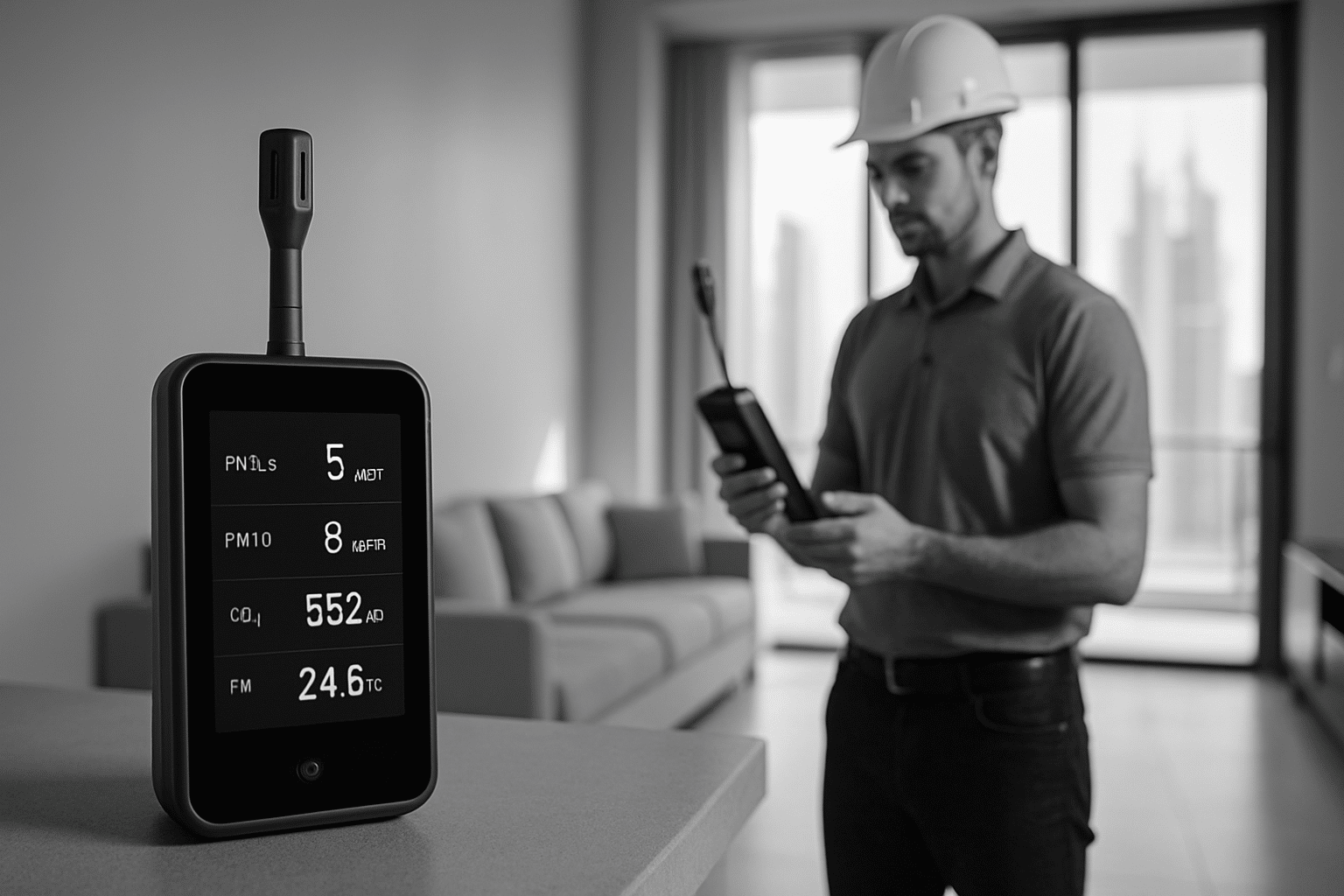
The Impact of Indoor Environmental Quality on Oxidative Stress: Insights and Interventions
Executive Summary
This white paper examines the significant role of Indoor Environmental Quality (IEQ) on oxidative stress levels in humans and its implications for health. Oxidative stress is a physiological condition where there is an imbalance between the production of reactive oxygen species (ROS) and the body’s ability to detoxify these reactive intermediates. This imbalance leads to cellular and molecular damage, contributing to the development of various chronic diseases. IEQ, which includes factors such as air quality, lighting, thermal conditions, and acoustics, directly influences oxidative stress through exposure to environmental pollutants and conditions conducive to stress and discomfort. By integrating current research findings, this document aims to underscore the importance of optimizing IEQ to mitigate oxidative stress and enhance overall human health.
Introduction
In the dynamic landscape of public health and environmental science, the quality of the indoor environment where individuals spend a significant portion of their time has emerged as a critical determinant of health and well-being. Indoor Environmental Quality (IEQ) refers to the quality of a building's environment in relation to the health and wellbeing of those who occupy space within it, encompassing air quality, thermal environment, lighting, acoustics, and ergonomics. Recent studies have increasingly linked poor IEQ to various health issues, including respiratory and cardiovascular diseases, neurocognitive disorders, and diminished psychological well-being. Among the mechanisms through which IEQ impacts health, oxidative stress—a biochemical imbalance resulting from an excess of ROS or a deficiency in antioxidant defenses—plays a pivotal role. Oxidative stress is implicated in the pathogenesis of numerous chronic conditions, aging, and general health decline, making the exploration of its relationship with IEQ a topic of paramount importance. This white paper delves into the complex interactions between IEQ and oxidative stress, highlighting how various elements of the indoor environment contribute to oxidative stress levels and, by extension, affect human health. It synthesizes findings from recent scientific research and epidemiological studies to provide a comprehensive understanding of this relationship. Furthermore, it seeks to offer actionable insights for stakeholders in public health, building design and management, and individual occupants to mitigate oxidative stress through improvements in IEQ.
This white paper delves into the complex interactions between IEQ and oxidative stress, highlighting how various elements of the indoor environment contribute to oxidative stress levels


Air Quality and Oxidative Stress: An Expanded View
the surrounding air. Exposure to VOCs can lead to a variety of health problems due to their ability to generate oxidative stress within the body. Particulate matter (PM) refers to a complex mixture of extremely small particles and liquid droplets that get into the air. Once inhaled, these particles can affect the heart and lungs and cause serious health effects, particularly as they can induce oxidative stress, leading to systemic inflammation and chronic diseases.
The nexus between indoor air quality (IAQ) and oxidative stress is a critical area of concern within environmental health science. Oxidative stress arises when there is an imbalance between the generation of ROS and the body's antioxidant defense mechanisms, leading to potential cellular and tissue damage. Indoor environments, where individuals spend a significant portion of their lives, can be rich sources of ROS due to various pollutants.
VOCs, PM, CO, nitrogen dioxide (NO2), and formaldehyde are prevalent indoor pollutants contributing to oxidative stress. These pollutants originate from a variety of sources, including cooking, smoking, burning candles, the use of cleaning products and personal care products, building materials, furniture, and outdoor air pollution infiltrating indoor spaces. For example, cooking activities, especially frying and grilling, can generate substantial amounts of PM and NO2, while smoking indoors significantly elevates levels of CO, VOCs, and PM.
The mechanism by which IAQ influences oxidative stress involves the direct and indirect effects of these pollutants on cellular structures and functions. Upon inhalation, these pollutants can generate ROS either directly by participating in redox reactions or indirectly by activating inflammatory cells that produce ROS as part of the inflammatory response. The excessive production of ROS overwhelms the body's antioxidant defenses, such as superoxide dismutase, catalase, and glutathione peroxidase, leading to oxidative damage to lipids, proteins, and DNA.
This oxidative damage is a well-established pathway contributing to the development and exacerbation of chronic diseases, including respiratory diseases (asthma, chronic obstructive pulmonary disease), cardiovascular diseases (atherosclerosis, hypertension), neurodegenerative diseases (Alzheimer's disease, Parkinson's disease), and cancer. Furthermore, oxidative stress is implicated in aging and has been linked to reduced immune function, making individuals more susceptible to infections and diseases.
Mitigating the impact of IAQ on oxidative stress involves targeted strategies to reduce indoor pollutant levels. Key measures include improving building ventilation to dilute and remove pollutants, using air purifiers with HEPA filters and activated carbon to filter particulate matter and adsorb gases, and controlling the sources of pollution, such as enforcing no-smoking policies, choosing low-emission building materials and furnishings, and using cooking vents. Additionally, incorporating plants that can absorb certain pollutants and maintaining a clean indoor environment can also help reduce the levels of indoor pollutants, thereby mitigating oxidative stress.
Educating occupants about the sources of indoor pollutants and their health impacts is crucial for empowering individuals to take proactive steps in improving IAQ. Building designers and engineers also play a critical role in creating indoor environments that support good IAQ through the use of non-toxic materials, efficient ventilation systems, and designs that maximize natural ventilation and light, further contributing to the reduction of oxidative stress and enhancement of occupant health and well-being.
Thermal Conditions, Lighting, and Acoustics: A Deeper Dive
The impact of thermal conditions, lighting, and acoustics on human health extends beyond comfort, influencing physiological processes that can lead to oxidative stress. The human body's response to these environmental factors can activate stress pathways, leading to the production of ROS and exacerbating the imbalance between antioxidants and prooxidants in the body.
Thermal Conditions
Thermal comfort, defined as the condition of mind that expresses satisfaction with the thermal environment, is affected by air temperature, humidity, air velocity, and the thermal properties of clothing and activity level. Uncomfortable thermal conditions, whether too hot or too cold, can lead to physiological stress. This stress response can increase the metabolic rate, leading to elevated production of ROS as byproducts of increased cellular metabolism. Moreover, extreme temperatures can disrupt the skin's barrier function, potentially leading to increased susceptibility to infections and inflammation, further contributing to oxidative stress.

Acoustics
Noise pollution, particularly in indoor environments, can be a significant source of stress and sleep disturbance. Chronic exposure to noise can lead to the activation of the body’s stress response system, the hypothalamic-pituitary-adrenal (HPA) axis, resulting in the release of stress hormones like cortisol. Elevated cortisol levels have been associated with increased oxidative stress, as the hormone can influence various metabolic processes that generate ROS. Furthermore, noise-induced stress can impair antioxidant defenses, making the body more susceptible to oxidative damage.
Mitigation Strategies
To mitigate the impacts of thermal conditions, lighting, and acoustics on oxidative stress, several strategies can be employed:
Thermal Conditions: Implementing smart heating, ventilation, and air conditioning (HVAC) systems that adjust temperature and humidity levels to maintain thermal comfort can reduce physiological stress. The design of buildings to enhance natural ventilation and insulation can also contribute to more stable indoor temperatures.
Lighting: Utilizing natural light as much as possible and adopting lighting systems that mimic natural light patterns can help maintain circadian rhythms. Reducing exposure to blue light from screens, especially before bedtime, is also crucial for preventing circadian disruption.
Acoustics: Soundproofing materials and design strategies can minimize indoor noise pollution. Implementing quiet zones and providing access to nature or nature sounds can help reduce stress and improve sleep quality, lowering the risk of noise-induced oxidative stress.
These strategies underscore the importance of a holistic approach to IEQ that considers all aspects of the indoor environment and their interplay in affecting oxidative stress and, consequently, human health.
Mitigation Strategies for Reducing Oxidative Stress through Improved IEQ
The strategies to mitigate oxidative stress by enhancing indoor environmental quality (IEQ) necessitate a comprehensive approach that encompasses not just a single element but the entirety of the indoor environment. This approach involves the integration of building design, occupant behavior, and technological interventions to create indoor spaces that support health and well-being by minimizing sources of oxidative stress.
Comprehensive Air Quality Management
Source Control: The most effective way to improve indoor air quality and reduce oxidative stress is to eliminate or reduce the sources of pollutants. This can be achieved through the selection of low-emitting materials for furniture, flooring, and paint, which minimize the release of volatile organic compounds (VOCs). Additionally, adopting no-smoking policies and using natural cleaning products can significantly reduce indoor pollutant levels.
Improved Ventilation: Increasing the flow of outdoor air into a building helps dilute and remove indoor pollutants. Utilizing advanced ventilation systems equipped with air filtration technologies capable of capturing particulate matter and gaseous pollutants can significantly improve indoor air quality. Regular maintenance of these systems ensures their efficiency and effectiveness in reducing oxidative stress.
Air Cleaning: Portable air cleaners and in-duct air purification systems can complement source control and ventilation. By selecting devices with HEPA filters for particulate matter and activated carbon filters for gases and VOCs, occupants can further reduce their exposure to indoor air pollutants that contribute to oxidative stress.
Optimizing Thermal Comfort
Adaptive Thermal Comfort Models: Implementing adaptive thermal comfort models that accommodate individual preferences and seasonal changes can enhance occupant satisfaction and reduce stress. Smart HVAC systems that adjust settings based on occupancy and weather conditions can maintain comfortable temperatures and humidity levels, thereby minimizing the physiological stress response associated with uncomfortable thermal conditions.
Insulation and Glazing: Enhancing the insulation of walls, roofs, and windows, and using thermally efficient glazing can stabilize indoor temperatures and reduce the need for mechanical heating and cooling. This not only conserves energy but also contributes to a more comfortable and stress-free indoor environment.
Lighting and Circadian Health
Circadian Lighting Design: Incorporating lighting systems that emulate the natural light cycle can support circadian rhythms and reduce the disruption associated with exposure to artificial light, particularly blue light. Utilizing dynamic lighting that adjusts color temperature and intensity throughout the day can help align the indoor environment with the occupants’ biological clocks.
Exposure to Natural Light: Maximizing exposure to natural daylight through architectural design features like skylights, large windows, and light shelves not only reduces reliance on artificial lighting but also supports mental and physical health by enhancing mood and sleep quality, thereby reducing oxidative stress.
Acoustic Comfort and Noise Reduction
Soundproofing and Noise Control: Implementing soundproofing materials in walls, ceilings, and floors can significantly reduce the transmission of external noise into indoor spaces. Designing quiet zones and using sound-absorbing materials and furnishings can help create a more tranquil indoor environment, reducing the stress response associated with noise exposure.
Noise Management Policies: Establishing policies to manage noise levels, such as designated quiet hours and the use of headphones for personal audio devices in shared spaces, can further contribute to reducing oxidative stress related to noise exposure.
By employing a holistic approach to improve IEQ, focusing on air quality, thermal comfort, lighting, and acoustics, it is possible to create indoor environments that minimize oxidative stress and promote health and well-being. These strategies require the collaboration of architects, engineers, building managers, and occupants to ensure that indoor spaces not only meet functional and aesthetic requirements but also support the physiological and psychological needs of those who inhabit them.
Final thoughts
The intricate relationship between indoor environmental quality (IEQ) and oxidative stress underscores a critical aspect of public health that demands greater attention. As we unravel the complexities of how air quality, thermal conditions, lighting, and acoustics within indoor environments influence oxidative stress, it becomes increasingly clear that these factors play a substantial role in shaping our health and well-being. Oxidative stress, being a pivotal mechanism underlying numerous health conditions, highlights the importance of optimizing IEQ not just for comfort, but as a vital preventive strategy against various diseases and as a means to promote longevity and quality of life.
The evidence presented in this white paper illuminates the multi-faceted nature of IEQ and its impact on oxidative stress, demonstrating that improvements in IEQ can lead to significant health benefits. By adopting comprehensive mitigation strategies that encompass air quality management, thermal comfort, circadian lighting, and noise reduction, we can create indoor environments that not only support human health but also enhance cognitive function, productivity, and psychological well-being.
This endeavor necessitates a collaborative effort among architects, engineers, health professionals, policymakers, and individuals. Building designs that prioritize IEQ, coupled with informed occupant behaviors and supportive public policies, can transform indoor spaces into health-promoting environments. Furthermore, ongoing research into IEQ and its relationship with oxidative stress will be crucial in developing evidence-based guidelines and technologies for healthier indoor environments.
In conclusion, improving IEQ represents a significant opportunity to mitigate oxidative stress and its associated health risks, underscoring the need for a holistic approach to building design and occupancy behavior. As we spend the majority of our time indoors, enhancing the quality of these environments is not only a matter of public health but also a moral imperative to ensure the well-being of current and future generations. By prioritizing IEQ, we take a critical step towards a healthier, more sustainable future where the built environment acts as a cornerstone of public health and human flourishing.
References:
[1] “Indoor air quality and health.” World Health Organization, 2018.
[2] “Oxidative stress, prooxidants, and antioxidants: The interplay.” Biochemical Society Transactions, 2014.
[3] “Indoor environmental quality and its effects on health: A review of evidence.” Science of The Total Environment, 2020.
[4] “Exposure to indoor air pollution and its impact on respiratory health.” Environmental Research, 2019.
[5] “Indoor plants reduce VOCs and increase indoor air quality.” HortScience, 2020.
[6] “Thermal comfort and the heat stress indices.” Industrial Health, 2010.
[7] “Effects of blue light on circadian biology and disease.” Current Biomarker Findings, 2020.
[8] “The role of noise in affecting human health: From stress to pathology.” Environmental Health Perspectives, 2019.
[9] “Indoor air quality and ventilation.” International Journal of Ventilation, 2021.
[10] “Thermal comfort in buildings.” Energy and Buildings, 2020.
[11] “Light, sleep, and circadian rhythms: Together again.” PLOS Biology, 2019.
[12] “Environmental noise and health.” Environmental Health Perspectives, 2020.
JV de Castro, IAC2
JV de Castro is the Chief Technology Officer at Saniservice, where he leads innovation in indoor environmental sciences, IT infrastructure, and digital transformation. With over 20 years of experience spanning architecture, building science, technology management, digital media architecture, and consultancy, he has helped organizations optimize operations through smart solutions and forward-thinking strategies. JV holds a Degree in Architecture, a Masters of Research in Anthropology, an MBA in Digital Communication & Media, along with certifications in mold, building sciences and advanced networking. Passionate about combining technology, health, and sustainability, he continues to drive initiatives that bridge science, IT, and business impact.







Leave a Reply